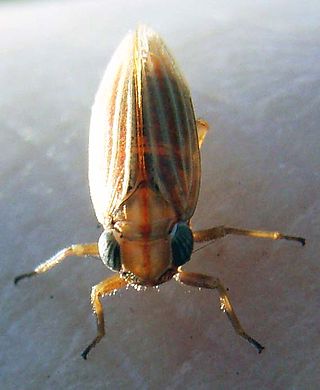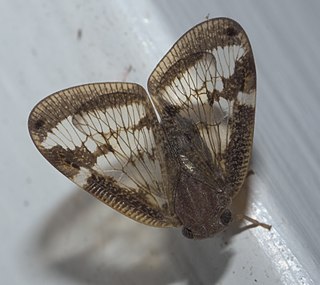
The family Fulgoridae is a large group of hemipteran insects, especially abundant and diverse in the tropics, containing over 125 genera worldwide. They are mostly of moderate to large size, many with a superficial resemblance to Lepidoptera due to their brilliant and varied coloration. Various genera and species are sometimes referred to as lanternflies or lanthorn flies, though they do not emit light.

Flatidae are a family of fulgoroid planthoppers. They are cosmopolitan in distribution and are distinguished from others in the superfamily by a combination of characters. Like all other planthoppers, they suck phloem sap of plants. Some species are known to communicate with vibrations through the plant stems. Communication may be with mates, or with ants that tend the nymphs, protecting them and gathering honeydew secretions. Adults of some species have brightly coloured forewings which are tougher and known as tegmina unlike the membranous hindwings which are used for flight. Although a few can be identified by their coloration, most species requires dissection and examination under a microscope with access to literature on already described species.

Issidae is a family of planthoppers described by Spinola in 1839, belonging to the order Hemiptera, suborder Auchenorrhyncha superfamily Fulgoroidea.

Caliscelidae is a family of planthoppers, sap-sucking insects that belong to the order Hemiptera, suborder Auchenorrhyncha and superfamily Fulgoroidea. They are somewhat anomalous and have often been included within the family Issidae. Studies made in 2013 of the phylogeny of the Issidae and other groups using molecular techniques support the treatment of the group as a separate family. Sexual dimorphism can be marked. Some members of the family are called piglet bugs due to the shape of their snout. A particularly aberrant genus described in 2011 from India, Formiscurra, has males that resemble ants.
The Elicini are a tribe of planthoppers in the family Tropiduchidae. The type genus is Elica.

Achilidae is a family of planthoppers, sometimes called "achilids" in the order Hemiptera. There are at least 520 described species in Achilidae.

Tropiduchinae is a subfamily of tropiduchid planthoppers in the family Tropiduchidae.

Dictyopharinae is a subfamily of dictyopharid planthoppers in the family Dictyopharidae. There more than 100 genera and 500 described species in Dictyopharinae.

Scolypopa is a genus of planthoppers in the family Ricaniidae. There are about eight described species in Scolypopa, found mainly in Australia and New Zealand.

The Hemisphaeriinae are a subfamily of bugs in the family Issidae, based on the type genus Hemisphaerius. Species in 107 genera have been recorded in most continents, but the greatest diversity appears to be in South-East Asia.

The Flatinae are a subfamily of planthoppers, erected by Maximilian Spinola in 1839. Genera have been recorded from all continents except Antarctica: especially in tropical and subtropical regions.

Euricania is a genus of true bugs belonging to the family Ricaniidae.

Pochazia is a genus of true bugs belonging to the family Ricaniidae.

Tambinia is a genus of planthoppers (Hemiptera) in the family Tropiduchidae and typical of the tribe Tambiniini ; species are found in Australia and Southeast Asia.
Tropiduchus is a genus of planthoppers, recorded from Africa and Malesia.

The Menoscinae are a subfamily of planthoppers in the family Lophopidae erected by Leopold Melichar in 1915. Most genera are recorded from SE Asia through to Australia, but the single genus in tribe Carrioniini is Neotropical.

The Plectoderini are a large tribe of planthoppers in the family Achilidae, erected by Ronald Gordon Fennah in 1950. Genera have a world-wide distribution, but are hardly represented in Europe or northern Asia.


















